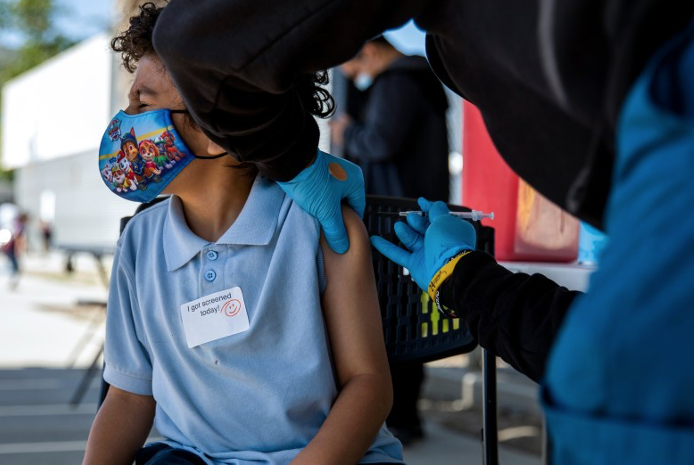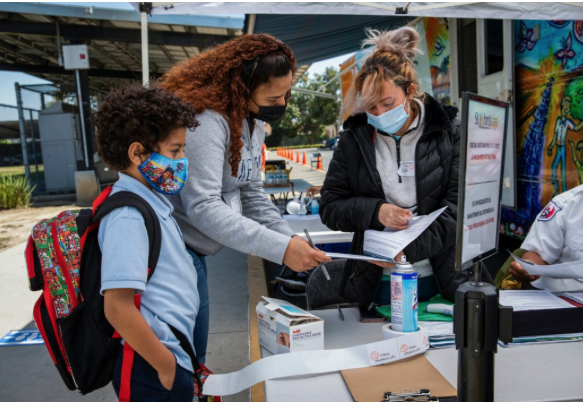CommentsCORONA VIRUS - Community clinics in California that have been waiting for more than a year to be reimbursed for COVID-19 vaccinations may soon be flooding state officials with tens of millions of dollars in bills.
The clinics, which serve California’s poorest and most vulnerable residents, may be owed as much as $408 million for the 6.1 million vaccinations they have administered to patients.
Now many clinics say they’re teetering on the edge of a financial cliff and desperately need the money from the state Department of Health Care Services. Some say they have already been forced to cut back patient services by reducing their hours or postponing doctor’s visits.
Without funds from the state, CEO Jim Mangia said St. John’s Well Child and Family Center in South Los Angeles will have to shut down vaccination efforts by April 1.
The largest community health clinic in Los Angeles, St. John’s has administered more than 441,000 COVID-19 shots, mostly to low-income people of color. The clinic is awaiting state payment for at least a third of them, costing $7 million; the rest have been reimbursed under private insurance.
“It’s frustrating because the state says they’re committed to vaccine equity, but they’re not paying the vaccine equity providers,” Mangia said.
California’s 1,300 community health centers are mandated to provide free or reduced-cost care to people with no or inadequate insurance. They’ve been integral to the state’s efforts to reduce vaccination inequities. About 80% of vaccines provided at California’s community clinics have gone to people of color, according to federal data.
The clinics were told not to submit claims to the state until now — a year after they spent millions ramping up to vaccinate patients — because the state and federal government had to figure out how to pay for vaccinations.
Last month, the federal government agreed to pay California $67 for each COVID-19 vaccination.
The Biden administration announced Tuesday that it had run out of money to pay for free COVID-19 vaccinations, tests and treatment. State officials said this will not affect reimbursement for vaccines already administered.
Health department officials said in a statement to CalMatters that they have no idea how much money they owe the clinics. The agency has yet to issue guidance on how exactly to submit their claims, and clinics don’t know how long it will take to get paid after sending the state their bills.
“It’s so painful that it’s been delayed,” said Andie Martinez Patterson, senior vice president of the California Primary Care Association, which represents community clinics. “Health centers have been holding millions of dollars of claims for over a year. We are desperate that it comes as soon as possible.”
Several clinics told CalMatters that services to their patients are suffering because of the payment delays, since they’ve been forced to use their federal emergency funds to cover the cost of vaccines instead of salaries and other primary care services.
Patterson said she hasn’t heard of any clinics closing, but many have cut back. That means fewer providers and longer wait times for patients who need medical care.
Where is the money?
Before the pandemic, there was no system in place to pay community clinics for a single service like a vaccine. Typically, shots or scans are billed as part of a provider visit, but that requires being seen by a doctor, which doesn’t happen at walk-up clinics or mass vaccine drives.
Instead, state officials told community clinics to hold onto their receipts while the Department of Health Care Services and federal government worked out the payment system.
The health department blames the federal government for the delay in payments. California’s initial request for alternative payment was submitted to the federal government in March 2021, but it wasn’t approved until the end of February, nearly a year later.
“The request for reimbursement for these ‘vaccine only’ visits required additional guidance from (the U.S. Centers for Medicare and Medicaid Services) and modifications to the original proposal,” a spokesperson said in a statement. Also, the state agency said it “needed to work collaboratively with clinics to obtain data to support the modified proposal of $67 per administration.”

Jayden Elizondo, 5, gets a Covid-19 vaccination at one of St. John’s Well Child and Family Center mobile health clinics in Los Angeles.
Photo by Alisha Jucevic for CalMatters
Community clinics say they felt a responsibility to administer vaccinations to their patients rapidly, even if payment wasn’t guaranteed.
“I don’t think there is anyone who lives in South LA who hasn’t lost a loved one, lost a job, lost a home because of COVID,” Mangia said. “In the midst of that incredible suffering, we decided to mobilize.”
St. John’s had considerable expenses, reaching millions of dollars: It purchased freezers to store 80,000 vaccines, opened 26 vaccination sites in Los Angeles and hired nearly 600 people to run the clinics six days a week.
The clinic received nearly $20 million in federal funds from the American Rescue Plan Act, which was supposed to subsidize primary care efforts. But Mangia said most of those funds were used to pay for vaccination efforts. The $7 million the state owes St. John’s is a drop in the bucket compared to its total costs, but it would still help, Mangia said.
Now, just as St. John’s is focusing its efforts on vaccinating children under 5, it will have to close its vaccination sites within two weeks without the funds.
“It’s not like we have the capacity to float that kind of money for an extended amount of time,” Mangia said.
In Orange County, the Families Together health center has consistently been among the top 10 vaccine providers, administering 56,000 shots in the past year. Between COVID-19 tests and vaccines, about 28,000 patient visits have not been reimbursed, CEO Alexander Rossel said. The clinic is owed at least $1 million for those services, Rossel said.
Last year the center’s board allocated general funds toward vaccination efforts despite not knowing whether they’d be reimbursed.
“We were struggling for a while. We used a lot of money to deliver these 56,000 vaccines,” Rossel said. “The emergency funds got to the state and the cities and not to the clinics. We’re still waiting for the money.”
Rossel said the clinic has worked hard to meet the community’s needs, vaccinating more than 80% of local teachers and sending a mobile clinic to restaurants and shopping centers to serve essential workers.
He said he’s disappointed in the lack of support and confidence from the state and local health department, which opted to first open mass vaccination drives at places like Disneyland. Rossel said low-wage workers couldn’t afford to wait hours in line or get the information needed to convince them the vaccine was safe.
Community clinics are still upset that the state health department didn’t prioritize them and get them vaccines quickly last year to help their low-income patients.
“We had to literally fight to get a hold of those vaccines. The federal government started giving us vaccines directly but that took six to eight months,” Rossel said.
Mangia said St. John’s also had to fight for vaccines, sending a letter to the state signed by 100 community organizations demanding the vaccine be sent to South Los Angeles after it had first been sent to UCLA and Cedars Sinai instead.
The delayed payment is yet another blow to the fragile, but essential, health care system.
“I’m not a politician. I don’t pretend to be, but I’m disappointed,” Rossel said. “I’m hoping and praying that the state and the county look back and learn what was the best way to deliver vaccines and resources, and I’m hoping they have learned that the community clinics were one of the top tier responders and they don’t forget about us again.”
The fallout at community clinics
Complicating matters, health centers are struggling with the same employee burnout that hospitals and private clinics have seen during the pandemic — but their margins are even thinner now.
“There’s a lot of fear around not having enough money to make it,” said Dori Rose Inda, CEO of Salud Para La Gente in Watsonville, which serves about 30,000 low-income patients.
Salud Para La Gente saw precipitous drops in revenue during the first six months of the pandemic when patients were told to avoid non-emergency care. They were only able to survive the past year with a $5 million American Rescue Plan Act grant, Inda said, but that money is all but gone.
“We literally pivoted everything to work differently during COVID,” Inda said. “Now as the grants are ending, we’re faced with…figuring out how to go full steam into primary and preventative care again and engage with people who are behind in the care that they need who may be sicker because of that.”
In Redding, at the Shasta Community Health Center, staff turnover has been high, with workers getting sick or burnt out. About 10% left when the state vaccine mandate for health care workers took effect, CEO Dean Germano said. He has five times more job openings than normal.
“When you don’t have a supportive workforce, it really does impact your clinical efficiency and patient happiness, too, if they can’t get through the phone quickly or get an appointment when they want it,” Germano said.
Revenues haven’t bounced back with patient visits still below pre-pandemic levels, particularly on the dental side, where the clinic sees only about half as many patients as before.
Shasta Community used some of its $5.6 million rescue grant to increase salaries to try and stay competitive, but most of it went toward breaking even on vaccine distribution, Germano said.
In Modesto County, Angela Millan said staff turnover is so high and funding so limited that some clinics at Golden Valley Health Centers have not reopened.
“They told us there was not enough staff or providers. They’re saying there’s not enough funds for these clinics to reopen,” Millan said.
Millan, who handles patient scheduling, said every few months she’s told to remove a doctor from the schedule because they’ve left, leading to long wait lists.
Long-term solutions needed for clinics
A bill introduced by state Sen. Bob Hertzberg, a Democrat from Van Nuys, aims to help alleviate some of the financial burden exacerbated by the pandemic by investing $400 million annually in community health centers to be spent on wages, workforce training and improved care.
He said the delayed COVID-19 vaccine payments are just one symptom of a long-standing funding gap for community clinics.
“Health care for millions of Californians is on the line if we fail to support our state’s community health clinics,” Hertzberg told CalMatters. About a third of the state’s 12 million Medi-Cal enrollees rely on community clinics for health care.
Employees at health centers make between 5% and 25% less than hospital workers, according to the Service Employees International Union, co-sponsors of Hertzberg’s bill. SEIU California represents roughly 14,000 health center workers.
“The wage gap is pretty significant,” said Joseph Bryant, president of SEIU 1021 in Northern California. “One of our clinics that we were recently able to get some substantial wage increases for, they were hovering just above minimum wage for many of the physician assistants, in the ballpark of $17 to low $20s.”
The state health center association has also made a budget request, asking for changes to be made in the way health centers are reimbursed, focusing on the value of services provided rather than volume.
Should either effort pass, workers say it could make a big difference.
Brisa Barrera, SEIU member and lead medical assistant at Santa Rosa Community Health, said two new medical assistants quit after three weeks because the workload was too much.
The churn is affecting patients too. Some referrals for specialty care are four months old, and specialists have told the clinic they can’t take any more patients.
“There are patients telling me ‘I don’t even bother calling the clinic anymore because the wait time for a live person to answer is over an hour.’ So treatments get delayed,” Barrera said.
She thinks about leaving herself sometimes, but as a former Medi-Cal patient, she knows it makes a big difference when patients see a face they recognize.
“My parents struggled because of translation, because of culture, because of their financial issues,” Barrera said. “These are patients that need access to care that don’t get the best care elsewhere. If I’m not here for my patients, who is going to take care of them?”
This story was updated to reflect that a source intended to say that physician assistants earn a certain wage, not physicians.
(Kristen Hwang reports on health care and policy for CalMatters. She is passionate about humanizing data-driven stories and examining the intersection of public health and social justice. She has previously worked as a beat reporter for The Desert Sun and a stringer for the New York Times California COVID-19 team. This story was published in CalMatters.org.)

















